The recent discovery of a minuscule moon orbiting Uranus marks a pivotal moment in planetary science. This seemingly insignificant object, only about 10 kilometers across, challenges our previous notions about the complexity of the Uranian system. While it may appear minor compared to the majestic giants like Jupiter and Saturn, this find underscores just how little we truly know about the intricate dance of celestial bodies circling Uranus. It reveals a fractal-like hierarchy of moons, rings, and debris, painting a picture of a dynamic and tumultuous environment that demands further exploration.
What makes this moon even more intriguing is its faintness and small size, which likely caused it to evade detection by earlier missions like Voyager 2. Its discovery by the James Webb Space Telescope (JWST) hints at a universe of complexities hidden in plain sight—obscured by technological limitations of the past. The fact that such a tiny object remains unnoticed in previous data emphasizes how far modern astronomy has come, yet also how much remains to be discovered. It invites us to reconsider the assumption that the outer reaches of planetary systems are well-understood and static.
Implications for the Evolution of Uranus’s Satellite System
The orbit of the newly discovered moon, designated S/2025 U1, suggests it formed in situ—indicating a relatively stable environment within Uranus’s inner satellite system. Located 56,250 kilometers from the planet’s center and nestled between other small moons, its nearly circular orbit hints at a calm, progressional past. In contrast, the chaotic history of Uranus’s larger moons and ring structures has long puzzled scientists, hinting at violent collisions or gravitational interactions that reshaped the system over eons.
Moreover, Uranus’s many small inner moons are uniquely configured, creating a complex interrelationship with the planet’s rings. This web of interactions blurs the traditional distinction between a ring system and a satellite system, making Uranus a living laboratory for studying planetary evolution. The discovery accentuates the importance of continuous observation, as there are likely many more hidden objects that could refine or redefine our understanding of planetary formation.
The Legacy and Future of Uranus Exploration
Decades after Voyager 2’s flyby in 1986, modern instruments like JWST are pushing the boundaries of what we can observe from afar. While Voyager provided groundbreaking insights into Uranus’s atmospheres and rings, it left many questions unanswered—particularly about the low-mass, inner moons and their origins. The new moon exemplifies how persistent technological advancement can unlock new layers of cosmic mystery.
The ongoing revelations emphasize a need for renewed exploration missions dedicated to Uranus. As the solar system’s least-understood giant planet, Uranus holds clues about planetary formation, satellite dynamics, and the broader evolution of ice giants—a class of planets that are common throughout our galaxy but remain enigmatic to us. Perhaps now is the time to revisit this distant world with a dedicated probe, armed with the latest technology to fully unearth its secrets.
This discovery positions Uranus not just as a distant, cold, icy world but as a dynamic, evolving system rich with surprises. It beckons us to keep searching, to look deeper, and to embrace the unknown—ushering in a new era of planetary exploration grounded in curiosity and relentless pursuit of knowledge.

